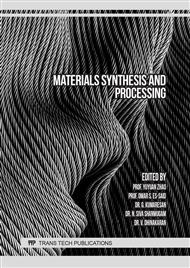[1]
J. Sun, Y. Wang, L. Tian, and C. Pan, Study on Preparation Technology of Self-healing Micro-nano Capsule based on Calcium Alginate,, 2018 IEEE Int. Conf. Manip. Manuf. Meas. Nanoscale, 3M-NANO 2018 - Proc., p.151–154, (2018).
DOI: 10.1109/3m-nano.2018.8552195
Google Scholar
[2]
S. N. Pawar and K. J. Edgar, Alginate derivatization: A review of chemistry, properties and applications,, Biomaterials, vol.33, no. 11, p.3279–3305, (2012).
DOI: 10.1016/j.biomaterials.2012.01.007
Google Scholar
[3]
A. Sharmila, M. S. Mardera, H. P. Soundarya, and M. Shreyas, Treatment of Textile Wastewater Using Sodium Alginate Beads,, J. Phys. Conf. Ser., vol.1979, no. 1, (2021).
DOI: 10.1088/1742-6596/1979/1/012005
Google Scholar
[4]
M. Yan, J. Shi, L. Liu, H. Zhu, S. Tang, G. Zhou, J. Zeng, H. Zhang, Y. Yu, and J. Guo, Preparation of high-strength and high-toughness sodium alginate fibers based on the study of multi-ion diffusion kinetics in a low temperature dissolution system,, New J. Chem., vol.45, no. 13, p.5981–5991, (2021).
DOI: 10.1039/d1nj00747e
Google Scholar
[5]
Z. Liu, X. Chen, and H. Guo, Preparation and Properties of a Novel Sodium Alginate Microcapsule,, J. Phys. Conf. Ser., vol.1893, no. 1, (2021).
DOI: 10.1088/1742-6596/1893/1/012005
Google Scholar
[6]
Q. Zhou, H. Kang, M. Bielec, X. Wu, Q. Cheng, W. Wei, and H. Dai, Influence of different divalent ions cross-linking sodium alginate-polyacrylamide hydrogels on antibacterial properties and wound healing,, Carbohydr. Polym., vol.197, p.292–304, (2018).
DOI: 10.1016/j.carbpol.2018.05.078
Google Scholar
[7]
A. Cerciello, P. Del Gaudio, V. Granata, M. Sala, R. P. Aquino, and P. Russo, Synergistic effect of divalent cations in improving technological properties of cross-linked alginate beads,, Int. J. Biol. Macromol., vol.101, p.100–106, (2017).
DOI: 10.1016/j.ijbiomac.2017.03.077
Google Scholar
[8]
M. Bajpai, P. Shukla, and S. K. Bajpai, Ca(II)+Ba(II) ions crosslinked alginate gels prepared by a novel diffusion through dialysis tube (DTDT) approach and preliminary BSA release study,, Polym. Degrad. Stab., vol.134, p.22–29, (2016).
DOI: 10.1016/j.polymdegradstab.2016.09.027
Google Scholar
[9]
G. T. Grant, E. R. Morris, D. A. Rees, P. J. C. Smith, and D. Thom, Biological interactions between polysaccharides and divalent cations: The egg-box model,, FEBS Lett., vol.32, no. 1, p.195–198, (1973).
DOI: 10.1016/0014-5793(73)80770-7
Google Scholar
[10]
A. Margaritis, F. J. A. Merchant, and W. Ontario, ADVANCES IN E T H A N O L PRODUCTION USING IMMOBILIZED CELL I . INTRODUCTION,, vol.I, no. 4, (1973).
Google Scholar
[11]
M. B. Cassidy, H. Lee, and J. T. Trevors, Environmental applications of immobilized microbial cells: A review,, J. Ind. Microbiol., vol.16, no. 2, p.79–101, (1996).
Google Scholar
[12]
B. B. Lee, P. Ravindra, and E. S. Chan, Size and shape of calcium alginate beads produced by extrusion dripping,, Chem. Eng. Technol., vol.36, no. 10, p.1627–1642, (2013).
DOI: 10.1002/ceat.201300230
Google Scholar
[13]
L. Zhang, J. Huang, T. Si, and R. X. Xu, Coaxial electrospray of microparticles and nanoparticles for biomedical applications,, Expert Rev. Med. Devices, vol.9, no. 6, p.595–612, (2012).
DOI: 10.1586/erd.12.58
Google Scholar
[14]
A. Mehregan Nikoo, R. Kadkhodaee, B. Ghorani, H. Razzaq, and N. Tucker, Controlling the morphology and material characteristics of electrospray generated calcium alginate microhydrogels,, J. Microencapsul., vol.33, no. 7, p.605–612, (2016).
DOI: 10.1080/02652048.2016.1228707
Google Scholar
[15]
F. Lotfipour, S. Mirzaeei, and M. Maghsoodi, Evaluation of the effect of cacl2 and alginate concentrations and hardening time on the characteristics of Lactobacillus acidophilus loaded alginate beads using response surface analysis,, Adv. Pharm. Bull., vol.2, no. 1, p.71–78, (2012).
DOI: 10.15171/apb.2016.045
Google Scholar
[16]
K. S. Huang, C. H. Yang, Y. S. Lin, C. Y. Wang, K. Lu, Y. F. Chang, and Y. L. Wang, Electrostatic droplets assisted synthesis of alginate microcapsules,, Drug Deliv. Transl. Res., vol.1, no. 4, p.289–298, (2011).
DOI: 10.1007/s13346-011-0020-8
Google Scholar
[17]
Y. Fukui, T. Maruyama, Y. Iwamatsu, A. Fujii, T. Tanaka, Y. Ohmukai, and H. Matsuyama, Preparation of monodispersed polyelectrolyte microcapsules with high encapsulation efficiency by an electrospray technique,, Colloids Surfaces A Physicochem. Eng. Asp., vol.370, no. 1–3, p.28–34, (2010).
DOI: 10.1016/j.colsurfa.2010.08.039
Google Scholar
[18]
J. Anani, H. Noby, A. Zkria, T. Yoshitake, and M. Elkady, Monothetic Analysis and Response Surface Methodology Optimization of Calcium Alginate Microcapsules Characteristics,, Polymers (Basel)., vol.14, no. 4, (2022).
DOI: 10.3390/polym14040709
Google Scholar
[19]
A. Partovinia and E. Vatankhah, Experimental investigation into size and sphericity of alginate micro-beads produced by electrospraying technique: Operational condition optimization,, Carbohydr. Polym., vol.209, no. December 2018, p.389–399, (2019).
DOI: 10.1016/j.carbpol.2019.01.019
Google Scholar
[20]
N. Kaur, B. Singh, and S. Sharma, Hydrogels for potential food application: Effect of sodium alginate and calcium chloride on physical and morphological properties,, ~ 142 ~ Pharma Innov. J., vol.7, no. 7, p.142–148, (2018).
Google Scholar



